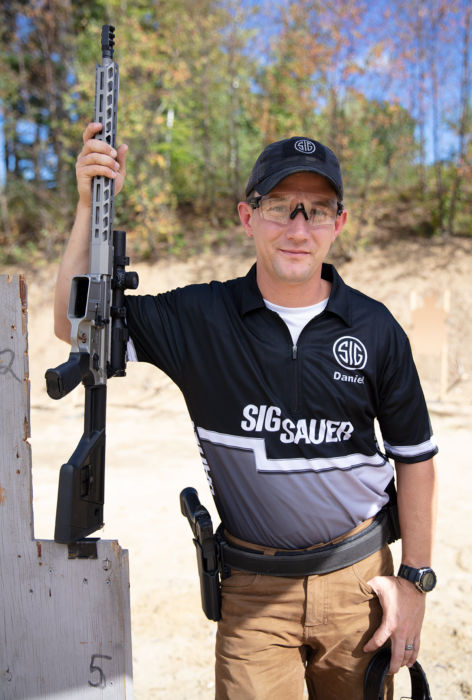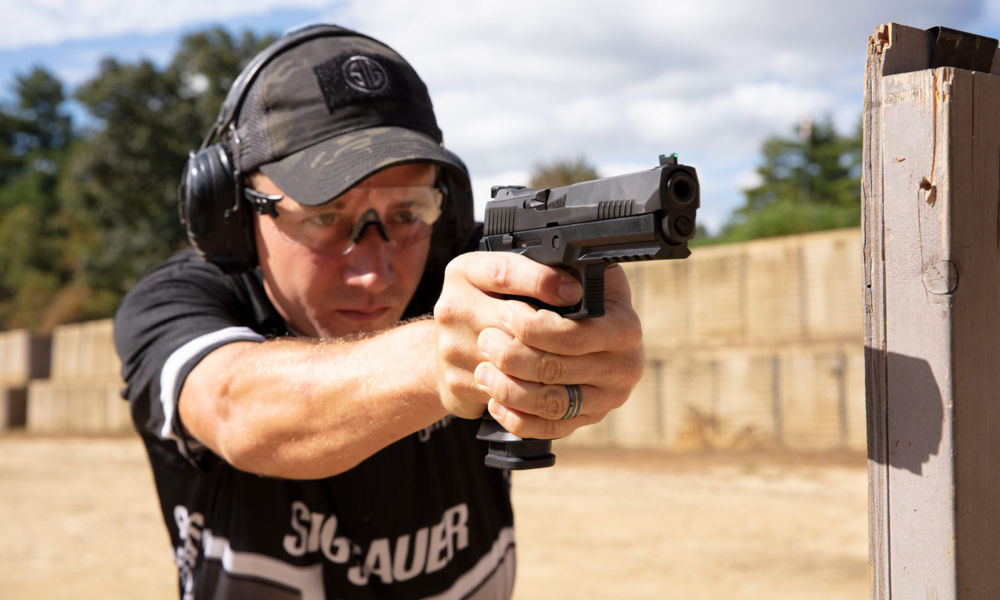Interview with Team SIG Shooter Daniel Horner
 In the fall of 2018, we announced that multi-discipline World Champion Shooter Daniel Horner officially joined the SIG SAUER Professional Shooting Team - Team SIG. Horner recently left the service of the U.S. Army where he rose to the rank of Sergeant First Class. He was recruited into the Army to join the U.S. Army Marksmanship Unit (USAMU) where he became one of the most decorated shooters in team history and served as Coach of the USAMU Action Shooting Team.
In the fall of 2018, we announced that multi-discipline World Champion Shooter Daniel Horner officially joined the SIG SAUER Professional Shooting Team - Team SIG. Horner recently left the service of the U.S. Army where he rose to the rank of Sergeant First Class. He was recruited into the Army to join the U.S. Army Marksmanship Unit (USAMU) where he became one of the most decorated shooters in team history and served as Coach of the USAMU Action Shooting Team.
Horner is a 3-gun shooter and will compete primarily in multi-gun matches, and long-range rifle competition as a member of Team SIG. In competitive shooting, Horner will use a P320 XFIVE full-size pistol with iron sights, an M400 SDI Comp rifle with a TANGO6 1-6x24mm first focal plane riflescope, and a KILO2400ABS. Horner will also use a variety of SIG SAUER Ammunition during competition including: 9mm Match Elite Competition, 223 REM Elite Match Grade, and 223 REM Varmint and Predator.
We recently had a chance to sit down with Horner to talk about guns, dogs, and swimming through pitch-black culverts in the middle of the night.
Q: How did you get started with firearms?
A: I grew up in Tidewater, Virginia and would go on duck hunts with my dad when I was 2 or 3 years old. I started carrying a shotgun hunting when I was 7. My dad is a veterinarian and one Saturday when I was 12, my dad was working. A guy came into the office and stuck a pistol in my dad’s face attempting to rob the place. He happened to lay the gun down for a quick second so my dad and another guy grabbed it and beat him up pretty him up badly. He was later sentenced to prison for 97 years. After that we started going to IDPA matches. I was too young to shoot so I ran around picking up brass, taping targets, keeping score. Eventually they let me shoot so I shot in my first IDPA match when I was 12 and won my first IDPA Nationals when I was 16. I started working at a range when I was 13. I was just doing yard help. I’d cut the grass, paint the targets and all the stuff you wouldn’t want to do. My mom was proud because I’d get up early to do my schoolwork and work late at the range up until I joined the Army.
Q: Is there a particular win in your competitive shooting career that sticks out as the most memorable?
A: 2014 International Sniper Competition at Fort Benning. Me and my buddy Tyler Payne won – we were so far ahead of our competition, we didn’t need to shoot the last few stages. Every sniper competition that we have entered, we’ve won.
Q: What was one of the more difficult competitions that's you've been in and why?
A: There was a sniper competition in 2012 with an obstacle course. During these competitions, you don’t know what’s going to happen. You’re told to just prepare your equipment and be ready. So, it’s day two of the competition and we’re 40 minutes into a deep sleep –and the only sleep I’d get. We’re in the competition holding area and that’s when I get kicked. I’m told to get my gun, night vision, one magazine, and my kit. So we go rolling out to the starting position and I’m told to ground my NODs and memorize the target engagement order in 30 seconds. I remember it one way and my partner remembers it in reverse order, and we’re told to proceed from this starting position to a tower a little ways away where we are to retrieve our equipment and conduct the course of fire. That’s when they move this lid on the ground. We always carry a head lamp in one pocket and a radio in another pocket. I look down to where the lid has been moved and I see that I’m jumping into water in a culvert at night and I didn’t know how far down it went. So I jump like airborne school with my feet and knees together and as I’m jumping, they snatch the headlamp out of my hand and yell “No f-ing cheating!” My partner and I land in about 3 feet of water and they close the lid over us. Now, it’s pitch black and we start walking sideways because the culvert is tapered starting with about 4 inches of air space and quickly going completely under water. But we didn’t know how long the culvert was. My partner wasn’t digging it at all. So I finally make it through and come out the other side and I hear someone drowning. He made it about three quarters of the way through then ran out of air so he backpedaled through the whole thing. I go back through the tunnel underwater and meet up with him. After we get it together, we turn around and he goes first. This time, I start getting the frog, like I was getting close to drowning. Then all of a sudden I feel a hand grab me by the plate carrier and snatch me through to a junction area like a hydraulic press. It was my partner. We take a quick break, grab another deep breath and finally come out the other side where we’re told to proceed to our equipment. So we start running, soaking wet, get to our position, lay down, turn on our night vision and start to acquire our targets. I turn to my partner and ask him if he remembered the target order. He says, “triangle, square, circle, circle.” So I start going down the line – triangle, square, circle and as I’m transitioning to the next target, the match director tells me to lock and clear my rifle. I look at him and say “it was triangle, square, circle, circle!” He says to me “What sized circle?” I’m like, "You sonafa. You almost killed me and now I have to remember if it was a six inch circle and not an eight inch circle?” That was a defining moment. That was a crazy one. But we ended up winning the competition and it was without a doubt the best competition that has ever been run. Ever.

Q: What’s your favorite discipline in 3-Gun?
A: Pistol for sure. I grew up shooting pistols and it’s just where I’m more comfortable.
Q: Who’s faster, you or Max Michel?
A: We’ll see.
Q: How do you prepare for matches?
A: Whatever I feel like I’m weak on, I just go do that at the range until I get to the point where I feel like I need to be at. It could be recoil management or movement or accuracy. Also, with the rifle, I’ll shoot paper out to 500 or 600 yards and then make sure the gun is perfect. That helps me a lot because you know exactly how and where you’re shooting.
Q: What do you do when you’re not competing?
A: I train dogs. I have two black Labrador retrievers. They’re duck hunting dogs. Zeus and Charlie.
PRODUCTS MENTIONED IN THIS POST:
Compare Products
Items